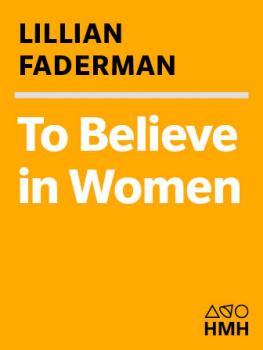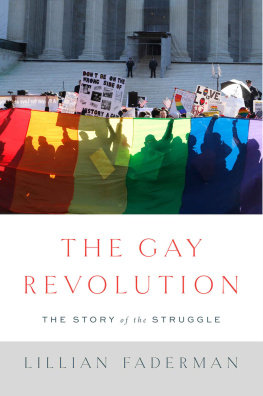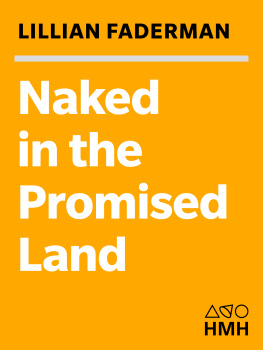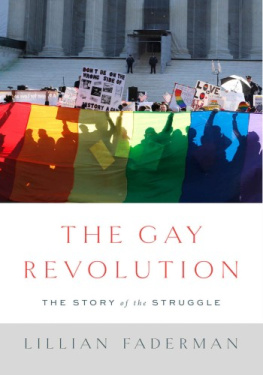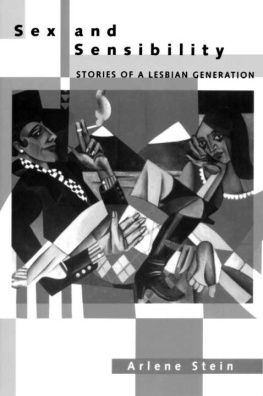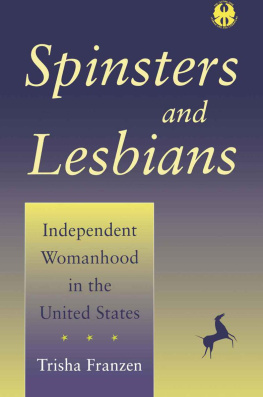Copyright 1999 by Lillian Faderman
All rights reserved
For information about permission to reproduce selections from this book, write to or to Permissions, Houghton Mifflin Harcourt Publishing Company, 3 Park Avenue, 19th Floor, New York, New York 10016.
www.hmhco.com
The Library of Congress has cataloged the print edition as follows:
Faderman, Lillian.
To believe in women : what lesbians have done for Americaa history / Lillian Faderman.
p. cm.
Includes bibliographical references and index.
ISBN 0-395-85010-x
1. Lesbian feminismUnited StatesHistory. 2. LesbiansUnited StatesHistory.
I Title.
HQ75.6.U5F35 1999
305.48'9664'0973 dc21 99-26209 CIP
e ISBN 978-0-547-34840-7
v4.0616
T O P HYLLISAGAIN
FOR EVERYTHINGAGAIN
I have forgotten everything I learned at Bryn Mawr, but I still see you standing in chapel and telling us to believe in women.
from a letter to Bryn Mawrs president, M. Carey Thomas, from an alumna
Acknowledgments
It would be impossible to write a book of this nature without the help of the numerous archivists and special collections librarians who very kindly assisted me in finding the papers I needed and often led me to materials that were invaluable for my research. My thanks to the staff at the Swarthmore College Peace Collection, the Huntington Library, the Nantucket Historical Association, the Bancroft Library of the University of California at Berkeley, the Bryn Mawr College Archives, the American Philosophical Society Library, the Archives and Special Collections at the Allegheny University of the Health Sciences, the Sophia Smith Collection at Smith College, the Vassar College Special Collections, the Wellesley College Archives, the Cornell University Rare and Manuscript Collections, the Schlesinger Library of Radcliffe College, and the Mount Holyoke College Archives and Special Collections.
I am especially grateful to Patricia Albright of Mount Holyoke College, Wendy Chmielewski of the Swarthmore College Peace Collection, Amy Hague of Smith College, Wilma Slaight of Wellesley College, Ellen Shea of the Schlesinger Library, and Jeanne Tempesta, head of Interlibrary Loan at California State University, Fresno.
I want to thank the friends and colleagues who very generously gave me their time, insight, and encouragement, reading numerous drafts of my manuscript and/or patiently listening to me spin out my ideas. My special gratitude goes to Joyce Brotsky, Rosie Pegueros, Dana Shugar, Linda Garber, Barbara Blinick, Steve Yarbrough, and Priscilla Allen. Heather Phillips and Sara Cable kindly shared with me their work on Pauli Murray. Joan Organ shared her work on Florence Allen. Margaret Bacon shared her work on Mildred Olmsted. Phyllis Irwins assistance with research and photography has been precious to me.
It would not have been possible for me to complete this book without the gift of time from my university and the help and understanding of the dean of the School of Arts and Humanities, Luis Costa.
I thank John Radziewicz, my editor, and his very patient assistant, Jenna Terry. As always during our twenty-year relationship, Sandra Dijkstra continues to be a wonderful agent and a good friend.
I thank Dawn Seferian for her early faith in this project and Steve Fraser for his good suggestions during the all-too-brief time I was fortunate to work with him. My special thanks go to my superb manuscript editor, Liz Duvall.
Introduction
Not-men, not-women, answerable to no function of either sex, whose careers were carried on, and how successfully, in whatever field they chose: They were educators, writers, editors, politicians, artists, world travellers, and international hostesses, who lived in public and by the public and played out their self-assumed roles in such masterly freedom as only a few medieval queens had equalled. Freedom to them meant precisely freedom from men and their stuffy rules for women.
Katherine Anne Porter, on nineteenth- and early twentieth-century lesbians
T HIS IS A BOOK about how millions of American women became what they now are: full citizens, educated, and capable of earning a decent living for themselves. It is also a book about how Americans developed a social conscience and adapted the goals of various reform movements into laws. But it departs from other such histories because it focuses on how certain late nineteenth- and early twentieth-century women whose lives can be described as lesbian were in the forefront of the battle to procure the rights and privileges that large numbers of Americans enjoy today.
For a variety of reasons, many of the women at the center of this book would not have used the noun lesbian to describe their identity, or even have been familiar with the word. However, using materials such as their letters and journals as evidence, I argue that that term used as an adjective accurately describes their committed domestic, sexual, and/or affectional experiences. I also argue that in their eras, lesbian arrangements freed these pioneering women to pursue education, professions, and civil and social rights for themselves and others far more effectively than they could have if they had lived in traditional heterosexual arrangements.
Lesbians Before Lesbian Identity
The emotional and sexual lives of many of the women discussed in this book were often complex. Most of them lived before the days when sexual identity was defined by clear-cut labels, and the noun lesbian would not in any case have been entirely adequate to identify all of them. Mary Dreier, for example, shared her life with another woman in a relationship that was almost certainly sexual, but she was also in love with a man she could not marry, and she probably did not consummate her attraction to him. Mildred Olmsted was married for most of her life and had a child with her husband, yet she was sexually uninterested in him, and throughout her marriage she continued a relationship with a woman that was emotionally and erotically intense. Still others loved and lived with women only. They may or may not have had sexual relationships with those women, but regardless, they saw them as their domestic spouses, partners, or lifelong loves. The binary paradigm of homosexual/heterosexual would probably have been baffling to many of them even if they had known those terms. However, what all these people had in common was that beloved women were centrally implicated in their emotional lives, and to a greater or lesser extent, their intimate relationships with other women helped enable their achievements.
To Believe in Women will perhaps be seen as being in opposition to postmodernism, which does not recognize the possibility of reclaiming women of the past as lesbians. Academic postmodernists might point to the precarious status of identitythe instability, indecipherability, and unnameability of sexualitiesand conclude that lesbianism cannot really be discussed, particularly in regard to history. With their epistemological doubts, they would be suspicious of any attempt to construct a coherent pattern out of complex human lives in order to create a grand narrative of history. Grand narrativesindeed, any such theoretical speculations, they would arguemust ultimately expose themselves as passionate fictions.
I believe that such arguments have merit and serve as an important corrective to a simplistic temptation to name the lesbians in history. As the postmodernists claim, it is impossibleespecially when dealing with historical figuresto make safe statements about identities, which are so slippery in their subjectivity and mutability. However, if enough material that reveals what people do and say is available, we can surely make apt observations about their behavior. That is what I have attempted to do in this book. I use the term lesbian as an
Next page
